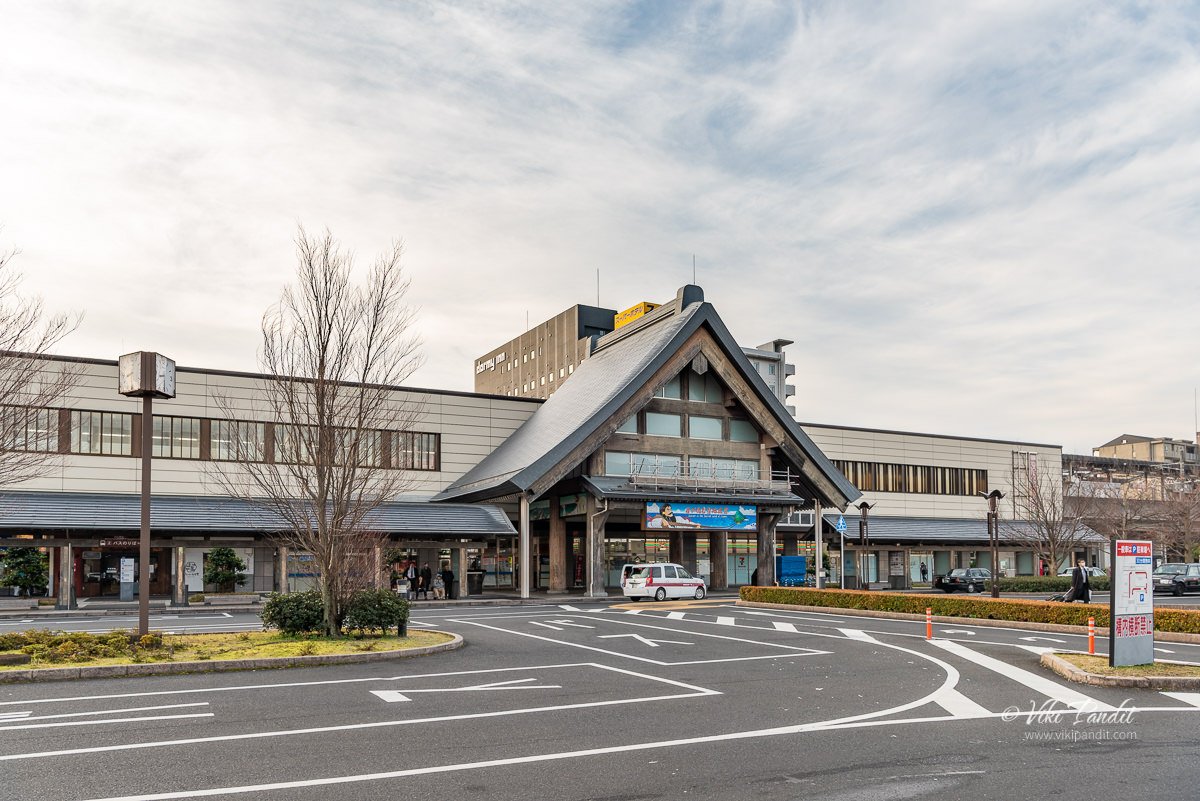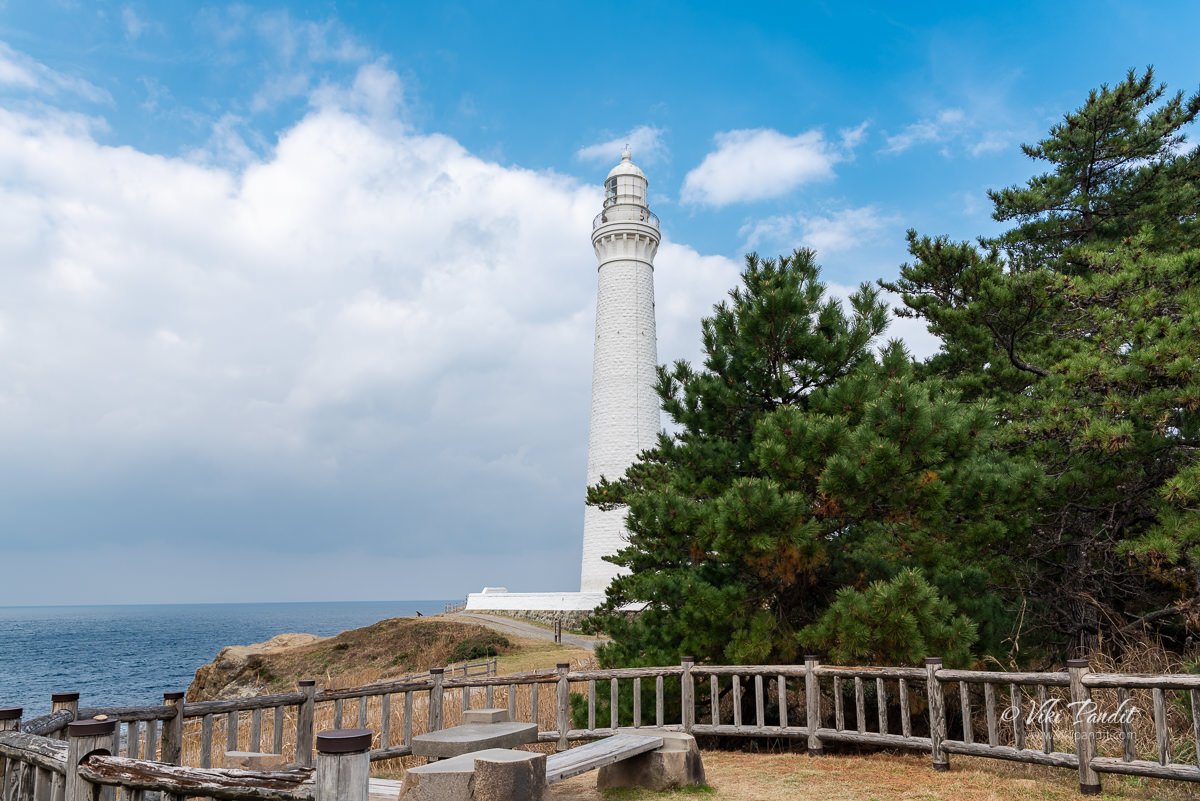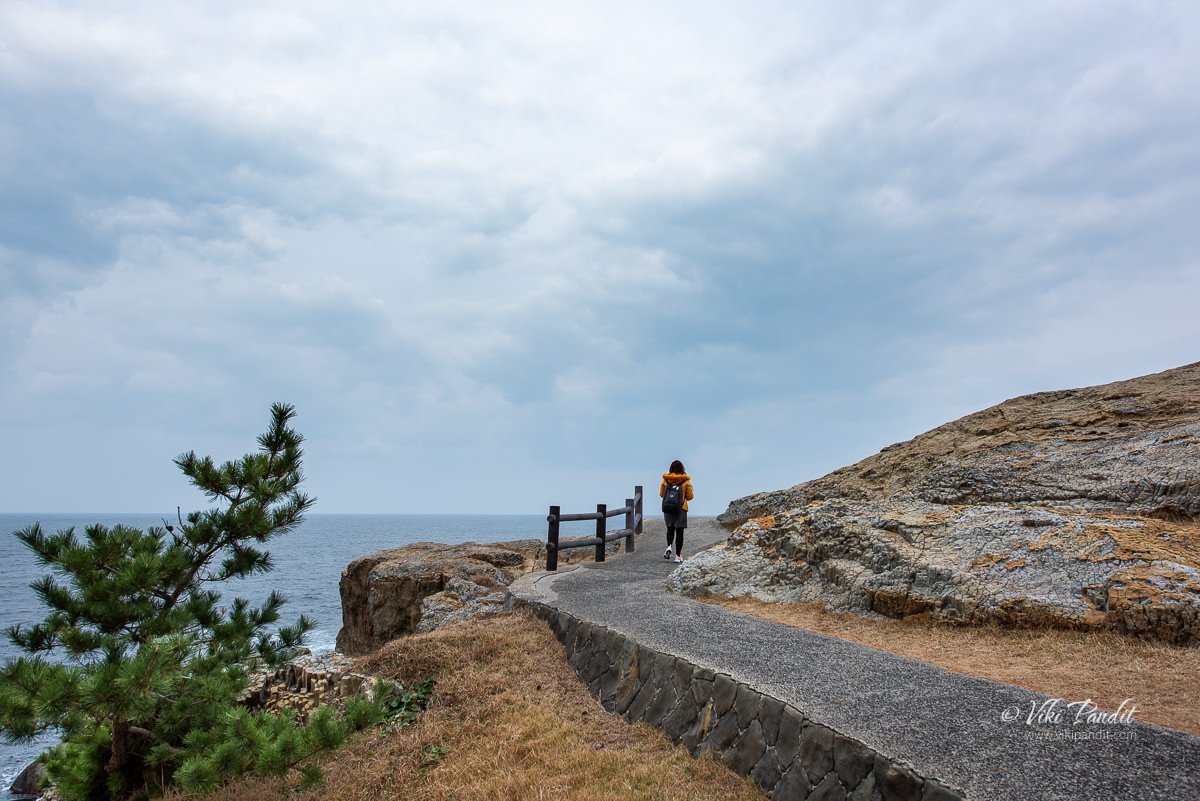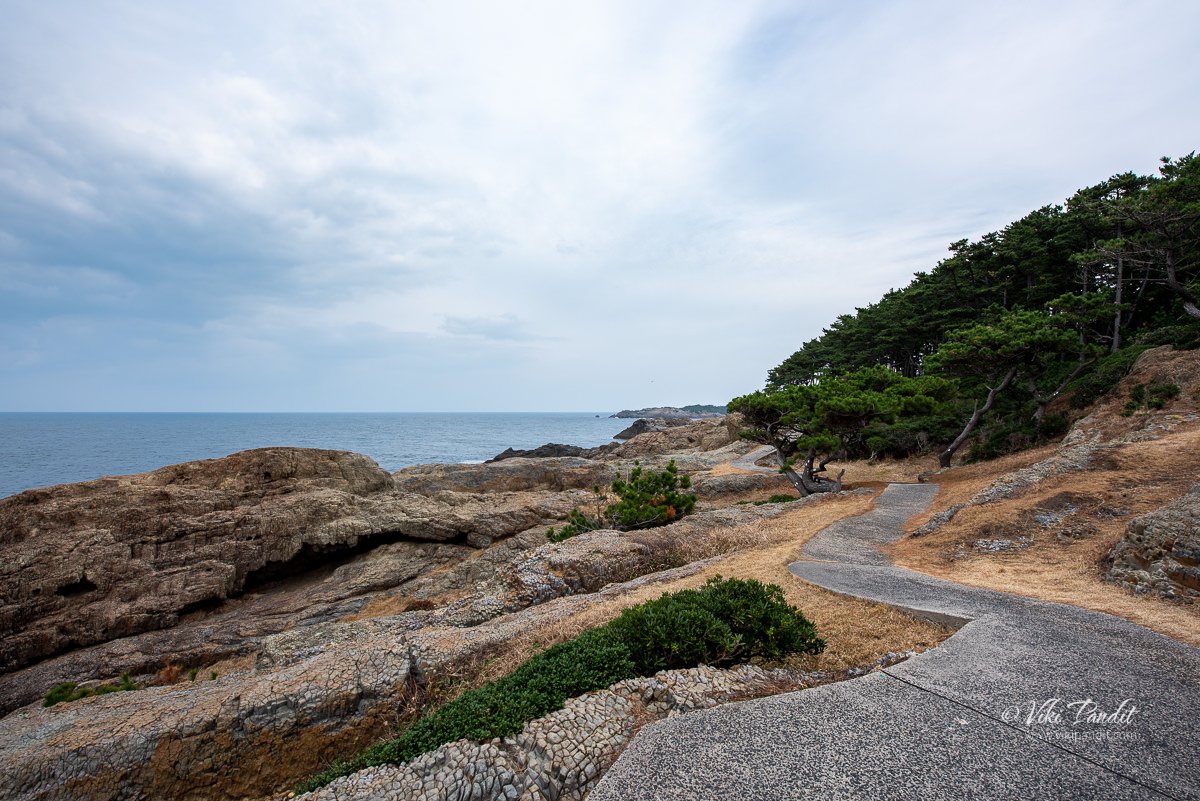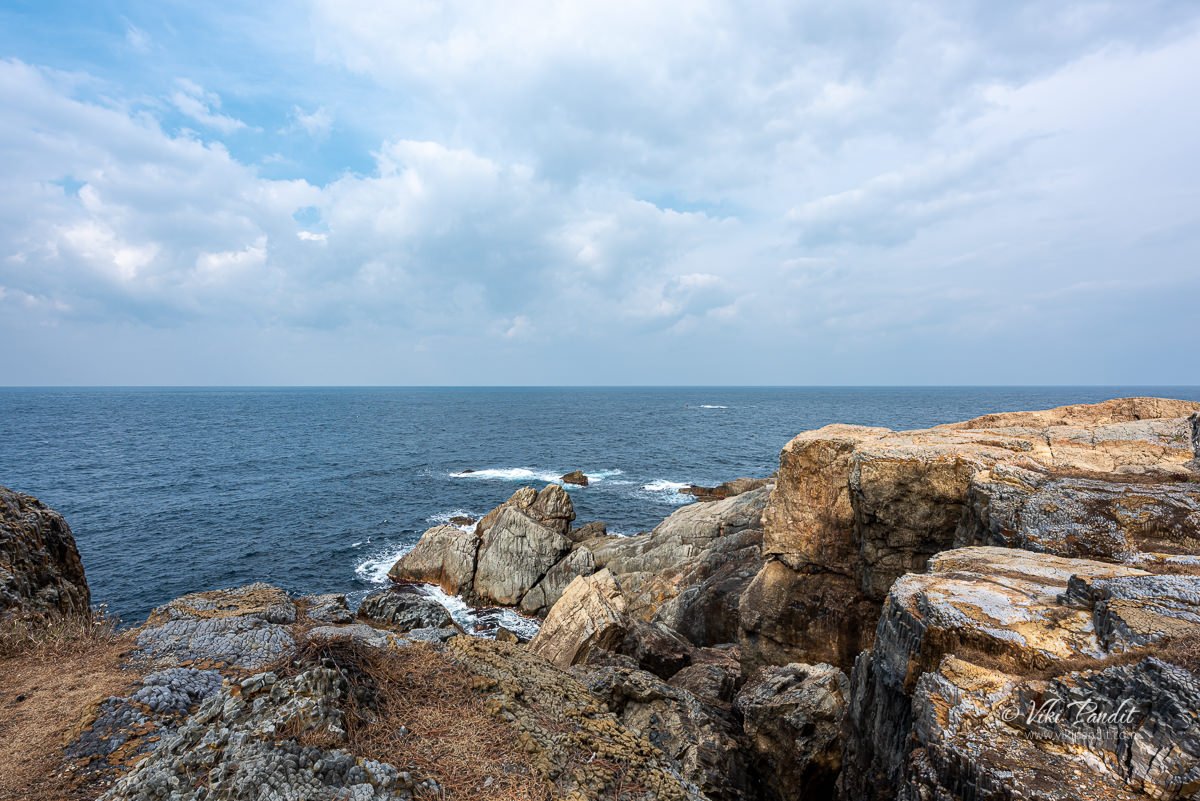Hinomisaki is a cape at the western-most part of the Shimane Peninsula. The Izumo Hinomisaki Lighthouse, which stands in the corner, boasts to be the highest masonry lighthouse in Japan. Situated in a quaint fishing village overlooking the rugged coastal terrain, this iconic guidepost has been aiding maritime navigation since 1903.
It was a pleasant morning. I and my wife, Mani, left the hotel at about 10 am. We were staying at the Dormy Inn Hotel, just behind Izumoshi Station. It is a nice place to stay, especially because of its proximity to the train station. The Wi-Fi access was pretty good and the room was nice. The hotel also provides a Japanese-Western semi-buffet with Izumo Soba for breakfast.
How to reach Hinomisaki Lighthouse
First thing you should know that there is no local train service to Hinomisaki Lighthouse. There are some direct buses to the lighthouse towards the afternoon, but in the morning time, you have to reach Izumo Taisha first. From there we were advised to change to a different bus that would take us the rest of the way to the lighthouse.
The bus stand is partly hidden from the main road, but after a bit of searching, we eventually found it. There was still some time on our hands before the departure to Hinomisaki Lighthouse, so we spent it exploring part of the Izumo Taisha grounds.
A day earlier when we had reached Izumo, we had already purchased the “En-Musubi Perfect Ticket” which is very helpful if you are going to use trains and buses for touring these parts. The ticket is priced at ¥3000, but we got it for just ¥1500 with a special discount for foreign tourists.
You will need to show your passport to avail the discount on the En-Musubi Perfect Ticket
We got back to the bus stand at the scheduled time. From Izumo Taisha, the bus takes about 20 minutes, on a narrow winding road along the coast, till it reaches the parking lot near the lighthouse. There are some sections along the route that are so narrow that with my level of driving skills, I would find it difficult to encounter an oncoming vehicle.
On the way, the bus also made a short stop at the Hinomisaki Shrine, where some of the people got off. Initially, we didn’t have any plans to visit the shrine, but we eventually did later in the day when we found out that it was just a short walk away from the lighthouse.
We reached the Hinomisaki Lighthouse parking lot just before noon. Once we got down from the bus, we were not very sure about the correct direction, so we instinctively just followed a group that had gotten off along with us. A narrow staircase from the parking lot led us into a wide road lined with shops selling souvenirs and local delicacies.
The area was mostly empty except for a school group, maybe because it was a Tuesday. The shops had on display shellfish specimens, capiz shells, and dried blowfish, some of them hanging outside the stores. You can also find various seafood items to eat if you are hungry including seafood bowls, squid grill, dried fish, set meals, and Izumo soba. One of the shops also sells grilled turban shells. After a short walk, the road turns right, and at the end of which there is a small gate-like entrance that has statues of a seagull sitting on either side.
As you enter this area you will find yourself in a wide-open space, with a couple of benches. It was here that we got to see the first full view of the bright white lighthouse standing majestically in the backdrop of a beautiful blue sky peppered with soft white clouds. The benches are placed in such a way that you can enjoy the thrilling view of the cape along with the towering lighthouse.
It was extremely windy so we decided to wait for the wind to calm down before we went to explore the lighthouse. On the left, a narrow pine-lined promenade goes all the way to the edge of the seashore. We went along the path which opened up to the unending sea just a few minutes into the walk.
The sea was calm. You could hear the waves gently splashing against the weathered rocks. As I got close to the edge, I was very impressed with the unique brown-grey-white texture of the weathered boulders. In the Hinomisaki area, you can see various occurrences of rhyolite that erupted about 16 million years ago along the sea cliff facing the Sea of Japan during the Pleistocene Epoch.
The Pleistocene Epoch is typically defined as the time period that began about 2.6 million years ago and lasted until about 11,700 years ago.
Over the years the sea and strong winds have created an immersive art on the rocks. The weathered rhyolite is at its thickest distribution near the promenade from the Hinomisaki Lighthouse. I love photographing subjects that have aged into their beauty. It is amazing how the weather, in the form of rain, wind, and the salty breeze have created these masterpieces over thousands of years. I can’t deny that I had a lot of fun capturing the beautiful weathered rock textures.
From down here, near the shore, you can also get a beautiful shot of the Hinomisaki Lighthouse. There are no fences on the cliffs, so if you plan on getting close to it, please be careful.
If you dare to go further down to the edge of the sea, you will find the rhyolite here is made up of 5 to 10 cm-sized blocks. This type of rock fracture is called a columnar joint. They are created when lava flows slowly, like toothpaste squeezed out of a tube, and tends to pile up forming lava domes. When it cools it forms a geometrical shape that combines four to four hexagonal columns. You can see those hexagonal columns towards the bottom of the below image jutting out like “Pockey” sticks.
From the southern shore, we walked along a cemented path to the northern side of the lighthouse, where I had heard you can see a beautiful cluster of islands spread across the sea.
The path goes along the coast. At some points where the cliff is steep, you do have safety railings.
The trail gradually leads to an area where we again have lots of Pine trees. As you near the pine forest, the sound of the wind blowing across the trees grows even louder.
Even though the trail is not tough, there is a rest stop along the way. More than rest, I believe visitors find it extremely relaxing to just sit there and enjoy a few minutes of peace from the fast life.
Just after the rest stop, the path curves to the right and we can see the first views of the bay.
Izumo Matsushima
After a short walk, we reached a high point from where you can view the beautiful bay referred to as “Izumo Matsushima”. A group of interesting rocks formed by the erosion of the waves and the waves of the sea is one of the scenes to cherish. There are about 20 large and small rhyolite islands spread over the vast bay.
Rhyolite is very hard and is not easily weathered or eroded. The rocky shores of Shimane Peninsula are an ideal breeding ground for seabirds, especially the umineko (black-tailed gulls). Thousands of black-tailed gulls gather on Fumishima Island in Hinomisaki Bay off the western tip of the Shimane Peninsula to breed from early November to July. The only other place in Japan where you can find the black-tailed gulls is in Kabushima Island in Aomori Prefecture.
We stayed there for a few minutes, deliberating if we could go a little further. The weather had improved by then. Eventually, we decided against it. So, after catching a breather, we began our walk back to the lighthouse.
Going back presented us with some different perspectives of the cape.
Unusual rocks and cliffs line the foot of the bedrock raised by sea erosion. You can enjoy the beauty of nature created by nature while listening to the sound of the waves splashing against the towering cliffs.
Near the lighthouse compound at some intervals, you will find special manhole covers depicting the lighthouse and seagulls. I am not a fanboy, but I do capture these manhole covers in Japan from time to time.
Hinomisaki Lighthouse
The construction of Hinomisaki Lighthouse was started in 1900, towards the end of the Meiji era (1868-1912) to promote shipping. It was completed by 1903. The structure is built in three layers with a copper tube in the center, a brick wall around it, and a masonry wall outside.
The outer wall is made of large stones from Mihoseki town in Matsue City. The inner wall is made of brick with empty space between the exterior stones. It is said that this structure was adopted to protect it against earthquakes. The outside is painted in white using special paint that is not easily affected by the harsh seaborne winds.
You are not allowed to wear shoes inside the lighthouse. There is a shoe-box on the ground floor where you can leave them. The floor inside is carpeted so you will not feel cold. The stairs are not, so you better hang on to your socks.
At the foot of the lighthouse, there is an exhibit room, which was opened to the public on March 11, 2011. The history and mechanism of the lighthouse are introduced here via panels and images. You can gather a lot of information about the lighthouse from aerial photographs and a panorama gallery.
The stairs to the observatory of the lighthouse are quite steep with 163 spiral staircases. If you are not confident in your physical fitness, it would be smarter to just enjoy the view from below. There is no elevator.
We took our time climbing the stairs. It was tough, especially with my tripod and camera gear, aiding gravity do its thing. There is a window along the way but you can’t see much outside. The lens room is on the 7th floor. Thankfully, there was no crowd.
Hinomisaki Lighthouse Tower and Lens
The light tower at the top was constructed using vertical stones from Moriyama city during the Taisho era. In its initial years, the light source used to be petroleum. In the second generation, it was upgraded to oil gasification and combustion which was later upgraded to a nitrogen incandescent light bulb.
When argon became more affordable, it was substituted for nitrogen. At present, the lighthouse uses a metal halide lamp – an electrical lamp that produces light by an electric arc through a gaseous mixture of vaporized mercury and metal halides. It produces a luminosity of 480,000 candelas and is designed to reach up to 21 nautical miles away.
let’s talk a little bit about the lens system of the lighthouse. Lighthouses have different color schemes and time intervals to illuminate in order for the ships to clearly identify each lighthouse. The lenses of the Hinomisaki Lighthouse consist of two small convex lenses for white light emission and one large convex lens for red light emission.
The structure is controlled by a motor to rotate once every 20 seconds, and one rotation makes it possible to generate two white flashes and one red flash. There are 4 seconds intervals between white and white flashes, 8 seconds between white and red flashes or 8 seconds between red and white flashes, for a total of 20 seconds to complete the cycle.
The flash is actually not a flash but a strong, condensed light when the lens and the light source overlap. Also, there is no red light source, it is generated by a red filter plate between the light source and the lens.
Before the current setup, in the Showa period, it was operated with a heavy “weight”. A weight of 500 kg was attached to the wire, and the wire was wound by a winder and moved with the weight of the weight. It was possible to wind for 8 hours with one winding, and the winding work was performed once or twice a day.
From this floor, you can go outside to the balcony. A stainless steel handrail surrounding the deck will protect you from swaying in the strong breeze. But let me warn you, the wind was quite powerful on the deck.
People with a fear of heights might have some difficulty walking along the deck.
From here you can get a panoramic view of the Sea of Japan. The 360-degree magnificent view enables you to see the same strange rocks and cliffs but from an entirely different perspective.
On a clear day, it is said that you can also see the Oki Islands from the observatory.
We had about 15 energizing minutes on the deck before another couple came in. We let them have their fun and started our descent down the tricky stairs.
Back on the ground, I captured a couple more shots of the sea before saying goodbye to the lovely bay.
The lighthouse illuminates about 40 km offshore at night, and even now, over 100 years later, plays its part in keeping the seafarers safe. Because of its rich history, the Hinomisaki lighthouse was selected as one of the “100 Historic Lighthouses of the World” in 1998. In 2013 it was designated as a national tangible cultural property. The Japanese government designates properties with high cultural values as “Important Tangible Cultural Property” to ensure sufficient protection.
Although seafarers rely a lot less on lighthouses today than they would have when this beacon was first built, there is still something undeniably captivating about these sea towers that draw me to visit them. The coast around Hinomisaki was beautiful and I was thrilled that I had time not only to view the scenery from the top of Hinomisaki Lighthouse (the first lighthouse I’ve climbed up in my life) but also the nearby park. From here we decided to walk down to Hinomisaki Shrine, which was just a 10-minute walk from the Lighthouse. On the way, we visited a couple of shops looking for a nice souvenir. I fell in love with this porcelain doll. It might just as well be a “Made in China” item, but it would look great among my souvenir collection.
Before walking out I also grabbed a matcha/vanilla softy ice cream. I just love those!
Photographs can never tell the emotions I felt standing on top of the Hinomisaki Lighthouse. I hope they can inspire some of you to reach out and witness what I have. If you have the chance to tour Izumo, do not miss this unique experience. I look forward to your comments and questions or you can connect with me directly on Instagram.
Annual events at Hinomisaki Lighthouse
The Izumo Hinomisaki Lighthouse Illumination is an annual light-up event that takes place every year at the lighthouse. It is also known as the “Love Lighthouse,” and is a very popular spot for couples. The annual schedule is mentioned below:
Izumo Taisha-mae Station
1903
August 21 -23 18:30~21:00 [ Geo Day Light Up ]
August 28 – 30 18:30~21:00 [ Weekend light up ]
September 4 -6 18:30~21:00 [ Weekend light up ]
September 11-13 18:30~21:00 [ Weekend light up ]
September 18-23 18:00~21:00 [ Respect for the aged day light up ]
September 24-30 18:30~21:00 [ Tuberculosis prevention week light up ]
